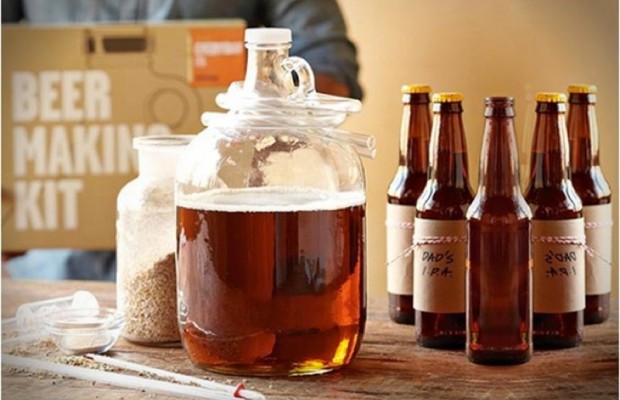Small Space Brewing: How Urban Dwellers Are Making It Work

If you think you need a garage, an outdoor shed or simply plenty of outside space to brew your own beer, think again. More and more urban dwellers are turning to small space brewing. Starting to homebrew in their own apartments, using their bathrooms, the laundry room or a combination of spaces (a little bit here, a little bit there) to brew beer.
That’s the case of Andrew Hale, a homebrewer and pharmacist located in Arlington Heights, Ill. Hale shares his apartment with his fiance Sarah and has managed to turn what he calls “high-rise brewing” into an art.
Q: People have the idea that you need a lot of space (an entire garage, for example) to brew, but that’s not really true. Just how little space do you really need?
Andrew Hale: I brew in an 800-square foot, high-rise apartment with a standard-size galley kitchen. For a brief time, we shared [with Sarah] a small studio, so this apartment seems huge by contrast. Still, I only have a hall closet and a cabinet or two to store my brewing supplies (right next to winter coats and the vacuum cleaner and the like). We have a balcony, but don’t have access to a hose to chill wort.
With a few exceptions, brewing all-grain is more difficult in a small space. The good news is you can brew with extract in any amount of space. I currently brew with liquid and dry malt extract (or sometimes both!). As long as you have a standard stove top and a sink to cool wort, you’re set. The biggest space concern is storing your equipment but generally this can be accommodated in a closet or in a spare cabinet or two.
If you live in a studio or a smaller apartment, it might be a stretch to use a five-gallon setup. Start with one gallon. Cooling the wort is less of an issue since you can do so in an ice bath. The only downside to one-gallon brewing is that most kits are made for five-gallon batches. One-gallon kits exist, such as those found at www.northernbrewer.com, but there is less variety. Starting with one gallon did force me to come up with my own recipes, so it was a blessing in disguise.
I’d encourage anyone who’s new to brewing to start with one gallon, even if you have a garage or shed to dedicate. One, brewing might not be for you. Two, even if you move on to five gallons, you can still brew gallon batches of experimental beers, as I do now. The equipment won’t go to waste if you upgrade, as you can reuse airlocks, stoppers, bottle cappers and the like. These are included with many one-gallon starter kits.
Q: What things can you eliminate or downsize in order to make the required space smaller? Anything you must give up for sure in order to brew in a small space?
AH: It’s unlikely that you’ll want to brew all-grain in a small space. That requires more intense heat than your stove top can deliver, and usually comes from a separate, more efficient propane burner. Without a separate burner, it is more of a hassle to mash and sparge (process used to extract usable sugars and starch from the grains to make wort). This is bypassed when you purchase liquid malt extract in a can or dry malt extract in a bag.
In addition, you have to get creative to cool wort in a smaller space or one without access to the outside. If you’re brewing one gallon, an ice bath in your kitchen sink is sufficient to cool the wort. For five gallons, you have to get creative. You can invest in a reverse wort chiller, which can be pricy. Or you can do as I did and rig up your own with copper tubing and a hose connected to the sink. It’s a strange-looking setup but it works (plus, it’s neat making literal bathtub brew).
Kegging can actually be more efficient than bottling. Some three-gallon kegs are the size of a Keurig. By kegging, you don’t have 50+ bottles lying in wait and you can store your beer all in one place. If you store your bottles in a hall closet, kegging also eliminates the potential for disaster if bottles are over-carbonated and explode.
Q: Any downsides to small-space brewing?
AH: You’re limited to the number of batches you can have ready at a given time, especially if you’re using a five-gallon setup. Of course, if you’re looking to produce a variety of beers, the one-gallon approach is still advisable. You could have multiple batches ready at any given time. For example, when I was still using my one-gallon setup, there were times when I actually had four different styles of beer ready to try out as some beers are ready within only four weeks. Others, such as barleywine, can take months to fully mature.
Some would argue that extract beer has less character than all-grain beer and while there may be some truth to that statement, it comes down to personal preference. So if you’re house hunting, storage space is just as important as a dedicated brewing space. Worst case scenario, if you don’t have space to store bottles upon bottles, you’ll have to invite a few people over to help you reduce your inventory.
















